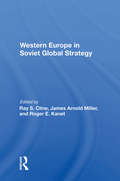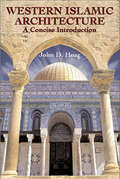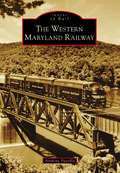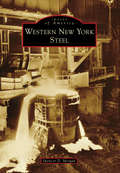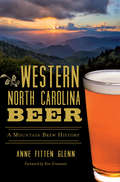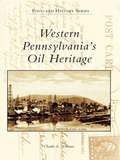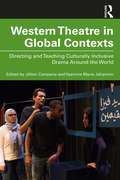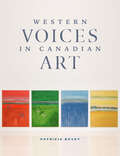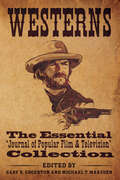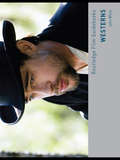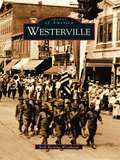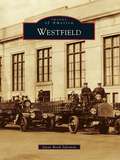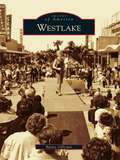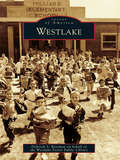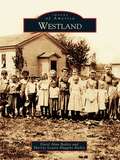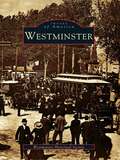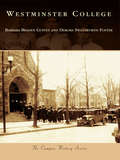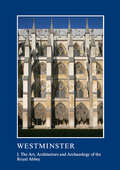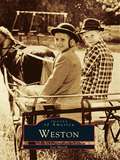- Table View
- List View
Western Europe In Soviet Global Strategy
by Ray S. ClineSoviet global strategy, long established and well understood by the Kremlin leaders, is to intimidate weak and fearful governments, exploit indigenous difficulties, disrupt social order, and promote communist revolutions. In this volume, European and American scholars describe the USSR's land and sea targets on and surrounding West Europe, where t
Western Islamic Architecture: A Concise Introduction (Dover Architecture)
by John HoagAmong the glories of world architecture, Islamic mosques and palaces — from Spain to Egypt and other parts of the Middle East — are universally studied and admired. This profusely illustrated introduction to that subject gives a lively account of the style of structures symbolized by domed mosques, mosaic-lined arcades, and filigreed interiors.A brief, scholarly essay, followed by drawings, maps, and photographs of excellent quality, contrasts — among other buildings — the airy internal ornamentation and almost elegant sensuality of Spain's Alhambra with the austerity of Egypt's Mosque of Ibn Tulun, both of which, in turn, are compared to the monumental Ottoman mosques built in Turkey.One of the most useful reference tools for studying architecture of the Islamic world, this "remarkably lucid survey … will be particularly valuable in high school and college libraries." — Best Sellers.
Western Landscaping: Companion to the Best-selling Western Garden Book
by Sunset Publishing Staff Kathleen Norris BrenzelThis all-new second edition, the companion book to the much-beloved Western Garden Book, promises to be just as successful as the first. Packed with expert advice from landscape designers, gardeners, and others, it addresses climatic, soil, and topographical challenge sand solutions for Arizona, California, Colorado, Idaho, Montana, Nevada, New Mexico, Oregon, Utah, Washington, Wyoming, and southwestern Canada. Features n The only landscaping guide designed specifically for Western gardeners n Over 600 photographs and dozens of ready-to-use landscape plans n Step-by-step illustrations and exploded views show easy, do-it-yourself solutions n Seasonal gardening guides and checklists ensure year-round success for experienced and novice gardeners alike n Easy-to-understand plant selection and growing instructions
Western Maryland Railway, The (Images of Rail)
by Anthony PuzzillaThe Western Maryland Railway was never a large Class 1 rail carrier, but during its 131 colorful years of existence, it provided extremely fast, efficient, and reliable freight; coal-hauling; and passenger service in the states it served. This book contains images from the history of this remarkable railroad and also provides the reader the opportunity to see how the legacy of the Western Maryland Railway is being maintained and remembered even today at some of its well-known train stations, such as in Cumberland and Union Bridge, Maryland, now home to the Western Maryland Railway Historical Society (WMRHS). The Western Maryland is now gone, but through the wonderful images captured and preserved by the WMRHS and private archival photograph collections, the dream of the railway will live on.
Western New York Amusement Parks (Images of America)
by Rose Ann HirschFor more than 100 years, western New Yorkers have enjoyed the region's exciting amusement parks. During the days of trolleys and steamships, area businessmen created Celoron Park, Crystal Beach Park, and other fine local summer resorts. Decades later, lifelong memories were formed for neighborhood baby boomers who visited Glen Park and Fantasy Island, as well as one of New York State's finest theme parks, Darien Lake. Western New York has always been a proving ground for some of the nation's most famous roller coasters. The terrifying Cyclone, the fast and furious Silver Comet, and the extreme Ride of Steel have attracted the very bravest of visitors. In the new millennium, the summer tradition of visiting local amusement parks continues with a blend of family-orientated parks and theme parks that appeal to all ages.
Western New York Steel
by Spencer D. MorganOver the past 200 years, Western New York has been witness to the socioeconomic rise and decline of a mighty steel industry. Like other rust belt cities, Buffalo, New York, was once an incredible financial and manufacturing superpower on the Great Lakes. The steel industry of Western New York was a leader of the Gilded Age and the embodiment of the postwar American dream. It employed almost a third of the regional population--many of whom still live in the area. As time progressed, failure to develop and compete with foreign contenders ultimately led to the collapse of its steel industry. Former steel workers have fought to keep this regional history alive and have contributed to this book. The Steel Plant Museum of Western New York, along with members of the community, have graciously assisted in the selection of images used to describe this once-great and influential industry.
Western North Carolina Beer: A Mountain Brew History (American Palate)
by Ken Grossman Anne Fitten GlennOver the past two hundred years, Western North Carolina has evolved from a mountainous frontier known for illicit moonshine production into a renowned destination for craft beer. Follow its story from the wild days of saloons and the first breweries of the 1870s through one of the longest Prohibitions in the nation. Eventually, a few bold entrepreneurs started the first modern breweries in Asheville, and formerly dry towns and counties throughout the region started to embrace the industry. The business of beer attracts jobs, tourists and dollars, as well as mixed emotions, legal conundrums and entrepreneurial challenges. Join award-winning beer writer Anne Fitten Glenn as she narrates the storied history of brewing in Western North Carolina.
Western Pennsylvania's Oil Heritage (Postcard History Series)
by Charles E. WilliamsThe discovery of oil flowing from a well in the wilds of northwestern Pennsylvania shook the modern world in 1859. Refined as kerosene for lamps, a lubricant for home and industrial needs, and ultimately as a fuel for transportation in the form of gasoline, oil literally changed the world and defined global economics and politics. Western Pennsylvania's Oil Heritage profiles the history of Pennsylvania oil from its discovery and development to its impact on the culture, economy, and environment of the oil region. These vintage postcards provide a glimpse into the wide-ranging history of western Pennsylvania's oil region, from the cradle of the industry at Oil Creek, to the immensely productive Bradford oil field, and on to cities and towns like Oil City, built largely by the black gold.
Western Scarves
by Diane ZamostA photo-filled look at the cowboy accessory that&’s become a modern work of art and fashion statement. No longer just a rag to wipe the sweat and dirt off a cowboy&’s face, western scarves have become a work of art. From hipsters to rock stars, this &“wild rag&” is a unique fashion statement. With beautiful photography, Diane Zamost, an expert in western clothing who&’s spent over twenty years buying and selling at horse shows, rodeos, and western arts festivals, takes the reader through the history of the scarf, its uses, and creative ways to tie it. Celebrate cowboy couture at its finest!
Western State College: Mountain Mecca
by Duane VandenbuscheWestern State College is located on Colorado's Western Slope, deep in the Rocky Mountains. It began as Colorado State Normal School, which was a two-year institution in 1911. Twelve years later, Colorado Normal became a four-year school--Western State College. Sitting at an altitude of 7,723 feet, it is the highest college or university in the nation. The elevation, the Rocky Mountains, two nearby ski areas, world-class mountain bike trails, stunning scenery, and the nearby Blue Mesa Reservoir (which is Colorado's second-largest tourist attraction) all combine to make Western State College an outdoor mecca, attracting students from all over the nation.
Western Theatre in Global Contexts: Directing and Teaching Culturally Inclusive Drama Around the World
by Yasmine Jahanmir Jillian CampanaWestern Theatre in Global Contexts explores the junctures, tensions, and discoveries that occur when teaching Western theatrical practices or directing English-language plays in countries that do not share Western theatre histories or in which English is the non-dominant language. This edited volume examines pedagogical discoveries and teaching methods, how to produce specific plays and musicals, and how students who explore Western practices in non-Western places contribute to the art form. Offering on-the-ground perspectives of teaching and working outside of North American and Europe, the book analyzes the importance of paying attention to the local context when developing theatrical practice and education. It also explores how educators and artists who make deep connections in the local culture can facilitate ethical accessibility to Western models of performance for students, practitioners and audiences. Western Theatre in Global Contexts is an excellent resource for scholars, artists, and teachers that are working abroad or on intercultural projects in theatre, education and the arts.
Western Voices in Canadian Art
by Patricia BoveyThe story of artists in Western Canada, and how they changed the face of Canadian art “Listen to the visual voices of artists. They tell us so poignantly who we are, what we must cherish, and what we must address as a society.” Patricia Bovey Throughout her remarkable career as a gallery director, curator, and author, Patricia Bovey has tirelessly championed the work of Western Canadian artists. Western Voices in Canadian Art brings this lifelong passion to a crescendo, delivering the most ambitious survey of Western Canadian Art to date. Beginning with the earliest European-trained artists in Western Canada, and moving up to present day, Bovey amplifies the depth, scope, and importance of the diverse artists (both settler and Indigenous) whose distinct voices have contributed to the Western Canadian artistic tradition. Bovey then adopts a thematic approach, richly informed by her knowledge and experience, connecting art and artists through time and across provincial boundaries. Insights from Bovey’s studio visits and conversations with artists enhance our understandings of the history and trajectory of, and impetus for Canadian artistic creation. Lavishly illustrated with over 250 works reproduced in full colour, Western Voices in Canadian Art is a book that needs to be seen, and its artists and art celebrated.
Western World Costume: An Outline History (Dover Pictorial Archive Ser.)
by Carolyn G. BradleyFrom prehistory to the mid-20th century, this informative book describes and illustrates the development of Western dress. The text — enhanced by nearly 500 illustrations — appears in outline form, permitting easy cross-referencing of material. Details of distinctive features for each era include footwear, headgear, accessories, and typical colors and materials. 491 black-and-white illustrations.
Westerns: The Essential 'Journal of Popular Film and Television' Collection
by Gary R. Edgerton Michael T. MarsdenFor nearly two centuries, Americans have embraced the Western like no other artistic genre. Creators and consumers alike have utilized this story form in literature, painting, film, radio and television to explore questions of national identity and purpose. Westerns: The Essential Collection comprises the Journal of Popular Film and Television’s rich and longstanding legacy of scholarship on Westerns with a new special issue devoted exclusively to the genre. This collection examines and analyzes the evolution and significance of the screen Western from its earliest beginnings to its current global reach and relevance in the 21st century. Westerns: The Essential Collection addresses the rise, fall and durability of the genre, and examines its preoccupation with multicultural matters in its organizational structure. Containing eighteen essays published between 1972 and 2011, this seminal work is divided into six sections covering Silent Westerns, Classic Westerns, Race and Westerns, Gender and Westerns, Revisionist Westerns and Westerns in Global Context. A wide range of international contributors offer original critical perspectives on the intricate relationship between American culture and Western films and television series. Westerns: The Essential Collection places the genre squarely within the broader aesthetic, socio-historical, cultural and political dimensions of life in the United States as well as internationally, where the Western has been reinvigorated and reinvented many times. This groundbreaking anthology illustrates how Western films and television series have been used to define the present and discover the future by looking backwards at America’s imagined past.
Westerns: The Institutes Of Architecture Of Western Australia (Routledge Film Guidebooks #1)
by John WhiteIt is a common assertion that the history of America is written in its Westerns, but how true is this? In this guidebook John White discusses the evolution of the Western through history and looks at theoretical and critical approaches to Westerns such as genre analysis, semiotics, representation, ideology, discourse analysis, narrative, realism, auteur and star theory, psychoanalytical theory, postmodernism and audience response. The book includes case studies of 8 key westerns: Stagecoach My Darling Clementine Shane The Good, The Bad and the Ugly McCabe and Mrs Miller Unforgiven Brokeback Mountain The Assassination of Jesse James by the Coward Robert Ford Including a chronology of significant events for the Western genre, a glossary and further reading, this introduction to an important genre in film studies is a great guide for students.
Westerville (Images of America)
by Beth Berning WeinhardtWesterville, Ohio, once known as the "Dry Capital of the World," has carved a niche for itself in history that few small towns can boast. Its industrious citizens founded Otterbein College, shaped an active business and social community, and attracted the nation's attention by taking a strong stand on the sale of alcohol. Wooed by the promise of land in a "dry" community, the Anti-Saloon League located their printing headquarters in the village in 1909. The photographs in this book capture Westerville as it grew and changed from the 19th century to 1961, when it officially became a city.
Westfield (Images of America)
by Jayne Book SalomonWestfield is a thriving suburban community, rich in history, culture, and civic pride. Located just 22 miles outside of New York City, it is affectionately know as "Colonial Westfield." In 1720, the "West Fields" of Elizabeth Town were settled by English immigrants. During the Revolutionary War, several altercations with the Red Coats took place here. Not only did George Washington stop in Westfield during the Revolutionary War, but it is believed he slept at the home of one of the town's forefathers. After the advent of the railroad in mid-1800s, the small but productive farming village gradually developed into the attractive upscale community it is today. Known for its high standards in education, emphasis on the arts, and religious and civic institutions, Westfield is one of the few suburban towns in New Jersey that continues to maintain an active downtown shopping area, complete with a major department store. With approximately 50 restaurants, it draws visitors from all over the state.
Westlake
by Bunny GillespieThe Westlake section of Daly City is the quintessential postwar suburban-modernist development, and it was the singular vision of Henry Doelger that made it so. Westlake was to the San Francisco Bay Area what Levittown was to New York after World War II, providing affordable housing for thousands of service veterans and war-industry personnel who remained in California after their tours of duty. The area abuts San Francisco's Sunset District, where Doelger built thousands of homes in the shifting sands before battling the dunes in northern San Mateo County in 1948. Doelger was lauded as the Bay Area's bestknown builder of homes, apartments, and shopping centers. Daly City increased in size almost by half when Westlake was annexed in 1948.
Westlake (Images of America)
by Westlake Porter Public Library Deborah S. RossmanThe city of Westlake was originally settled as part of Dover Township. In the period between 1811 and 1840, the pioneers cleared the forest to make way for agriculture. The land shaped the boundaries of the township, a 15.9-square-mile area rich in farms, dairies, orchards, and vineyards. The town's businesses grew and prospered, and Dover became the second-largest shipping point for grapes in the United States. Over time the farms have disappeared from the landscape, but the city's proud heritage continues today. Westlake is an opportunity to experience not only the past events in the city of Westlake but also the lives of the people who call Westlake home.
Westland (Images of America)
by Daryl Alan Bailey Sherrye Louise BaileyIn May of 1825, Reverend Marcus Swift traveled along the middle branch of the Rouge River until he found a place he thought was close to heaven. Soon streets, homes, and businesses were established as more pioneers arrived in Nankin Township. In 1963, the J.L. Hudson Company chose Nankin Township as the site of a new shopping mall called Westland. When the mall became a target for annexation, residents joined forces to create their own city. Thus, the city of Westland was born. Through rare photographs drawn from various sources, this book takes readers on a journey through nearly 200 years of local history, from the death of Chief Tonquish to the present day.
Westminster
by Westminster Historical SocietyIt almost was not Westminster. The small town in central Massachusetts was born to another name, that of Narragansett 2, and it was not for another twenty years that the area became known as Westminster. One early settler, Abner Holden, described it as "a howling wilderness." Today's Westminster is a charming Colonial town, with the impressive peak of Mount Wachusett overlooking its rolling hills and its pristine lakes and ponds.In Westminster, the story unfolds from the first settlers gathering on Academy Hill to weather the bleak early years to the joyous return of the soldiers from the bloody battles of World War II. It portrays the early inventive entrepreneurs, along with the sturdy men and women who made the town's blueberries famous and its chickens delicious. Savor the memories of the Westminster Cracker Factory and the golden corn fritters of the well-known Old Mill Restaurant, recall the bustling chair factory of Artemus Merriam, and remember the wartime heroes and eager faces of Westminster's children. Capture in Westminster the spirit of the town's residents joining together in celebration and tragedy, from the first festive centennial parade to the pain of devastating fires.
Westminster College (Campus History)
by Barbara Braden Guffey Debora Swatsworth FosterDuring the mid-1800s, a small band of farsighted men convened to form a college for "the mental and moral training of youth." They also pledged that "no person will be refused admission on account of Color, Caste or Sex." This was a bold move on the eve of the Civil War. As Presbyterian Church representatives, the founders selected the name Westminster Collegiate Institute. In 1852, Westminster became the first integrated and unrestricted coeducational college in the country. Today it is one of America's most admired small liberal arts colleges. Westminster remains on the cutting edge of teaching and learning while valuing the interaction between faculty and students. The New Wilmington campus has been home to successive generations of scholars who have gone on to excel ina wide range of endeavors. Westminster College serves as a tribute to the school's past and present students, preserving the images of their specialmemories and favorite places.
Westminster Part I: The Art, Architecture and Archaeology of the Royal Abbey (The British Archaeological Association Conference Transactions)
by Warwick Rodwell; Tim Tatton-BrownThe British Archaeological Association’s 2013 conference was devoted to the study of Westminster Abbey and the Palace of Westminster. It also embraced Westminster School, which was founded at the Reformation in the Abbey precinct. Collectively, these institutions occupy a remarkable assemblage of medieval and later buildings, most of which are well documented. Although the Association had held a conference at Westminster in 1902, this was the first time that the internationally important complex of historic buildings was examined holistically, and the papers published here cover a wide range of subject matter. Westminster came into existence in the later Anglo-Saxon period, and by the mid-11th century, when Edward the Confessor’s great new abbey was built, it was a major royal centre two miles south-west of the City of London. Within a century or so, it had become the principal seat of government in England, and this series of twenty-eight papers covers new research on the topography, buildings, art-history, architecture and archaeology of Westminster’s two great establishments — Abbey and Palace. Part I begins with studies of the topography of the area, an account of its Roman-period finds and an historiographical overview of the archaeology of the Abbey. Edward the Confessor’s enigmatic church plan is discussed and the evidence for later Romanesque structures is assembled for the first time. Five papers examine aspects of Henry III’s vast new Abbey church and its decoration. A further four cover aspects of the later medieval period, coronation, and Sir George Gilbert Scott’s impact as the Abbey’s greatest Surveyor of the Fabric. A pair of papers examines the development of the northern precinct of the Abbey, around St Margaret’s Church, and the remarkable buildings of Westminster School, created within the remains of the monastery in the 17th and 18th centuries. Part II part deals with the Palace of Westminster and its wider topography between the late 11th century and the devastating fire of 1834 that largely destroyed the medieval palace. William Rufus’s enormous hall and its famous roofs are completely reassessed, and comparisons discussed between this structure and the great hall at Caen. Other essays reconsider Henry III’s palace, St Stephen’s chapel, the king’s great chamber (the ‘Painted Chamber’) and the enigmatic Jewel Tower. The final papers examine the meeting places of Parliament and the living accommodation of the MPs who attended it, the topography of the Palace between the Reformation and the fire of 1834, and the building of the New Palace which is better known today as the Houses of Parliament.
Westminster Part II: The Art, Architecture and Archaeology of the Royal Palace (The British Archaeological Association Conference Transactions)
by Warwick Rodwell; Tim Tatton-BrownWestminster came into existence in the later Anglo-Saxon period, and by the mid-11th century, when Edward the Confessor’s great new abbey was built, it was a major royal centre two miles south-west of the City of London. Within a century or so, it had become the principal seat of government in England, and this series of twenty-eight papers covers new research on the topography, buildings, art-history, architecture and archaeology of Westminster’s two great establishments — Abbey and Palace. Part I begins with studies of the topography of the area, an account of its Roman-period finds and an historiographical overview of the archaeology of the Abbey. Edward the Confessor’s enigmatic church plan is discussed and the evidence for later Romanesque structures is assembled for the first time. Five papers examine aspects of Henry III’s vast new Abbey church and its decoration. A further four cover aspects of the later medieval period, coronation, and Sir George Gilbert Scott’s impact as the Abbey’s greatest Surveyor of the Fabric. A pair of papers examines the development of the northern precinct of the Abbey, around St Margaret’s Church, and the remarkable buildings of Westminster School, created within the remains of the monastery in the 17th and 18th centuries. Part II part deals with the Palace of Westminster and its wider topography between the late 11th century and the devastating fire of 1834 that largely destroyed the medieval palace. William Rufus’s enormous hall and its famous roofs are completely reassessed, and comparisons discussed between this structure and the great hall at Caen. Other essays reconsider Henry III’s palace, St Stephen’s chapel, the king’s great chamber (the ‘Painted Chamber’) and the enigmatic Jewel Tower. The final papers examine the meeting places of Parliament and the living accommodation of the MPs who attended it, the topography of the Palace between the Reformation and the fire of 1834, and the building of the New Palace which is better known today as the Houses of Parliament.
Weston
by Lee MarshEstablished in 1713 as a Puritan town, Weston, Massachusetts, has been a center of farming, industry, estates, and now, suburban life. Weston traces the changes in the city from the colonial period into the 20th century, with emphasis on the developments of the Progressive era (1900-1920), a time in which the area's most admirable features were established. At the turn of the century,Weston was a community enjoying peace and prosperity while addressing the changes brought about by the transportation and industrial revolutions. Roads and railroads connected Weston to the greater Boston area, and the Hews Pottery, Hobbs Tannery, and Hastings Organ Factory gave the town some experience with the effects of the industrial revolution. Industry virtually disappeared from the town by 1935, but during the "estate era," which lasted from the 1880s to the 1950s, estates and land were sold to build housing for the new suburbanites. Photographs from the Weston Historical Society as well as private sources illustrate the changes in town life and landscapes; memoirs from residents and the "Weston Column" of the Waltham Free Press tell the story of a community that has maintained its independent and unique character for more than 200 years.
